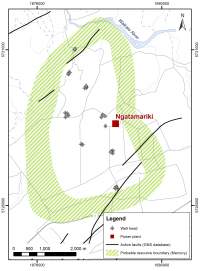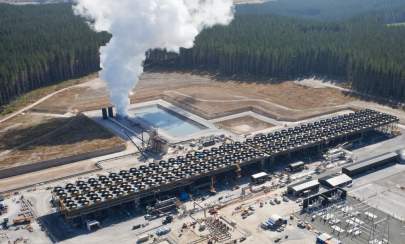Ngā Tamariki Geothermal System
Location and general description

The Ngā Tamariki Geothermal System is located within the Waikato Region, 5km south of Orakeikorako and 17 km north-east of Taupo. The Ngā Tamariki Geothermal Development is located within what was the Tahorakuri Forest, and is bordered by farmland to the east and west, and the Waikato River along the northern and southern boundary. The field covers an area of about 7 to 12 km2.
The Waikato Regional Plan classifies the Ngā Tamariki Geothermal System as a Development Geothermal System where the take, use and discharge of geothermal energy and water will be allowed, while:
- remedying or mitigating significant adverse effects on Significant Geothermal Features; and
- avoiding, remedying or mitigating adverse effects on other natural and physical resources including overlying structures (the built environment).
This classification is based on:
- Few surface outflows vigorously depositing sinter.
- No evidence of a flow of subsurface geothermal fluid to or from a Protected Geothermal System.
Local Geology and geophysics, wells drilled, etc.
The Crown drilled four exploration wells in 1985-86, with four further delineation wells drilled by Mighty River Power (now Mercury NZ Ltd.) from 2008, including one well 3,373m deep. The resource temperature ranges from 255°C up to 287°C.
Ngā Tamariki’s geology from surface to +200m RL is dominated by surficial deposits of alluvium, including Orakonui Breccia and Whakapapataringa rhyolite, and lacustrine sediments of the Huka Falls Formation. Underlying the near surface volcanic-sedimentary sequence is crystal-rich tuff and breccias of the regionally-extensive Wairoa Formation, partly welded crystal-lithic Wairakei Ignimbrite, and Akatarewa Ignimbrite and andesite (Tahorakuri Formation). Torlesse greywacke (basement) beneath the andesite layer has been intersected only by NM6 to date. Underlying the andesite lava and breccias in NM4 is a quartz diorite pluton.
Natural features
Compared with other geothermal fields, the Ngā Tamariki field has few surface thermal features and only a small outflow of geothermal fluid. The surface features that are present are located at the Ngā Tamariki hot springs where sinter, pools and hot springs are part of a reserve administered by the Department of Conservation. A hydrothermal eruption was reported in 2005.
Significant Geothermal Feature types present include:
At Orakonui Springs
- Geothermally-influenced aquatic habitat
- Geothermally-induced atmospheric microclimate
- Geothermally-influenced water body (pools)
- Heated ground habitat
- Hydrothermal eruption crater
At Waikato River Springs
- Geothermally-influenced aquatic habitat
- Geothermally-induced atmospheric microclimate
- Geothermally-influenced water body (pools)
Geothermal vegetation
The geothermal ferns Christella aff. dentata (“thermal”), Cyclosorus interruptus and Dicranopteris linearis are present. D. linearis is known from only c.23 sites in New Zealand. Psilotum nudum, a plant restricted to geothermal and northern coastal areas, geothermal kanuka, and the geothermal moss Campylopus capillaceous are also present. The geothermal fungus Lycopodiella cernua is found at the Orakonui Springs.
Existing and historical geothermal uses

The Ngā Tamariki Power Station was commissioned in 2013. It has four Ormat 20.5 MW(e) binary cycle units, the largest Ormat Binary Cycle units in the world at the time they were commissioned, with a total rated capacity of 82 MW(e).
The power plant is owned and operated by Mercury NZ Ltd., with the steamfield and resource consents jointly owned by Mercury NZ Ltd. and Tauhara North #2 Maori Trust.
The steamfield comprises seven active geothermal wells, including three production and four re-injection wells, each extending to a depth of more than 3,000m. There are also 21 shallow to intermediate depth monitoring wells, drilled to a depths of up to 1,500m, as well as a number of deep stand-by and monitoring wells. A production make-up well was drilled in 2017.
A pilot project to test the technical viability of re-injecting produced non-condensible gases (mainly carbon dioxide) was started in 2021.
Inferred size of resource
Based on initial stored heat models, the power development potential could be about 175 MW(e).



